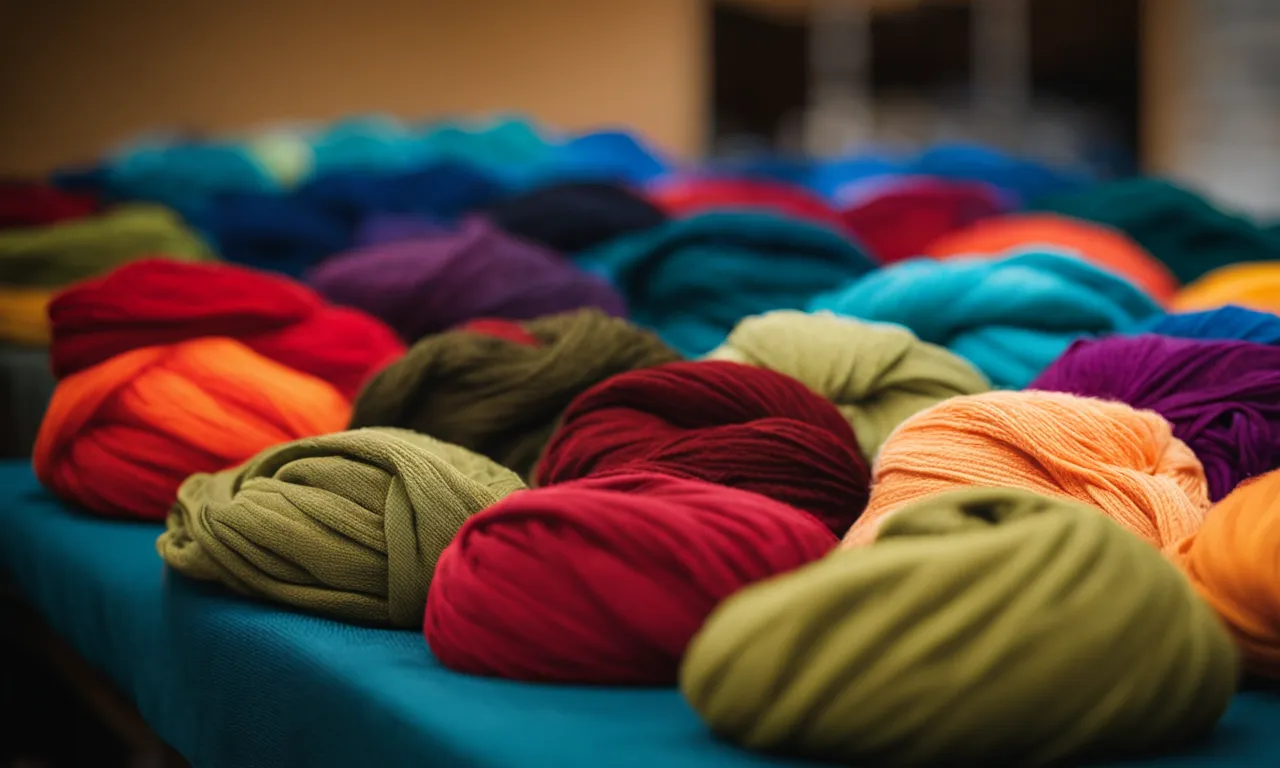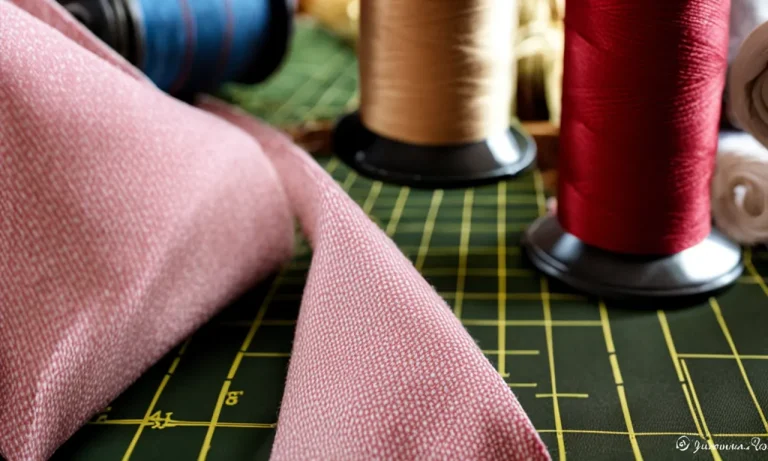How To Dye Acrylic Fabric: A Step-By-Step Guide
Dyeing acrylic fabric allows you to transform bland, neutral fabrics into vibrant works of art. With the right dyes and techniques, you can easily dye acrylic fabrics at home to create custom pieces. If you’re short on time, here’s a quick answer to your question: To dye acrylic fabric, you need special dyes made for synthetic fabrics, and you use low, simmering heat to open up the fibers to accept the dye.
In this comprehensive guide, we’ll walk through everything you need to know to successfully dye acrylic fabric yourself. You’ll learn about picking the right dyes, prepping your fabric, techniques for applying dye, how to set the color, and caring for your finished piece.
Choosing Dyes for Acrylic Fabric
Look for Dyes Formulated for Synthetics
When it comes to dyeing acrylic fabric, it is important to choose dyes that are specifically formulated for synthetic materials. These dyes are designed to adhere to the unique properties of acrylic, ensuring long-lasting and vibrant color results.
Using dyes that are not suitable for synthetics may result in poor color absorption and fading over time.
One popular brand that offers dyes formulated for synthetic fabrics is Dharma Trading Co.. They provide a wide range of acid dyes and fiber reactive dyes that are suitable for acrylic fabrics. Acid dyes work best with nylon, while fiber reactive dyes are more suitable for polyester and other synthetic fibers.
It is important to follow the instructions provided by the dye manufacturer to achieve the best results. This may include pre-treating the fabric with a special dye fixative or using specific dyeing techniques.
Types of Dye for Acrylic
There are different types of dyes available for dyeing acrylic fabric, each with its own characteristics and application methods.
| Type of Dye | Characteristics | Application Method |
|---|---|---|
| Acid Dyes | Highly concentrated and vibrant colors, suitable for nylon and acrylic | Requires heat and an acid dye bath |
| Fiber Reactive Dyes | Long-lasting colors, suitable for polyester and other synthetic fibers | Requires heat and a soda ash solution |
| Disperse Dyes | Suitable for sublimation printing and dyeing polyester | Requires high heat and pressure |
It is important to choose a dye that is compatible with acrylic fabric. Acid dyes and fiber reactive dyes are the most commonly used options for dyeing acrylic. Disperse dyes are more suitable for sublimation printing or dyeing polyester fabrics.
Remember to always read the instructions provided by the dye manufacturer and conduct a small test on a scrap piece of fabric before dyeing the entire garment or project.
Preparing the Acrylic Fabric
Before dyeing acrylic fabric, it is important to properly prepare it to ensure the best results. Here are some essential steps to follow:
Wash the Fabric
The first step in preparing acrylic fabric for dyeing is to wash it. This helps to remove any dirt, oils, or other substances that may be present on the fabric. Simply toss the fabric into the washing machine and use a mild detergent.
Avoid using fabric softeners or bleach, as they can affect the dye absorption.
Remove Stains and Sizing
If there are any stains or sizing on the fabric, it’s important to remove them before dyeing. Stains can interfere with the dye absorption, resulting in uneven coloring. To remove stains, pretreat the fabric with a stain remover and follow the instructions on the product.
Sizing, which is a substance applied to the fabric during manufacturing to give it stiffness, can also interfere with dye absorption. To remove sizing, soak the fabric in warm water with a small amount of mild detergent for about 30 minutes, then rinse thoroughly.
Wet the Fabric Before Dyeing
Before applying the dye, it’s important to wet the fabric thoroughly. This helps to ensure even dye distribution and penetration. Fill a sink or basin with warm water and submerge the fabric completely. Gently agitate the fabric to ensure it is fully saturated.
Once the fabric is wet, wring out any excess water, leaving it damp but not dripping. This will help the dye to adhere more effectively to the fabric fibers.
By following these steps to prepare your acrylic fabric, you’ll be well on your way to achieving vibrant and long-lasting dye results.
How to Dye Acrylic Fabric
Acrylic fabric can be easily dyed at home using various methods. Whether you want to give new life to an old acrylic garment or create a unique piece of fabric, dyeing acrylic is a fun and creative process. In this step-by-step guide, we will explore different techniques for dyeing acrylic fabric.
Stovetop Dyeing
One popular method for dyeing acrylic fabric is stovetop dyeing. This technique involves boiling the fabric in a dye bath on the stovetop. Start by choosing a fabric dye that is suitable for acrylic fibers. Follow the instructions on the dye package for the correct proportions of dye and water.
Heat the dye bath on the stovetop, add the fabric, and let it simmer for the recommended amount of time. Stir the fabric occasionally to ensure even dye distribution. Once the desired color is achieved, rinse the fabric thoroughly and let it dry.
Bucket Dyeing
Another method for dyeing acrylic fabric is bucket dyeing. This technique is ideal for larger pieces of fabric or for when you want to create a gradient effect. Fill a large bucket with hot water and add the fabric. Dissolve the fabric dye in a separate container according to the package instructions.
Pour the dye into the bucket and stir well. Let the fabric sit in the dye bath for the recommended amount of time, stirring occasionally. Rinse the fabric thoroughly and hang it to dry.
Tie Dye
Tie dyeing is a popular technique for creating vibrant and colorful designs on acrylic fabric. Start by twisting, folding, or tying the fabric in various ways to create patterns. Secure the fabric with rubber bands to hold the design in place.
Prepare the fabric dye according to the instructions on the package. Apply the dye to the fabric using squeeze bottles or brushes, making sure to saturate the fabric thoroughly. Place the dyed fabric in a plastic bag or wrap it in plastic wrap to keep it moist.
Let the fabric sit for several hours or overnight to allow the dye to set. Rinse the fabric until the water runs clear and let it dry.
Ombre Dyeing
Ombre dyeing is a technique that creates a gradient effect on the fabric, going from a lighter shade to a darker shade. To achieve this look, start by preparing a dye bath in a large container. Dip one end of the fabric into the dye bath and let it sit for a few minutes.
Slowly lift the fabric out of the dye bath, allowing the dye to gradually fade. Repeat this process, dipping the fabric deeper into the dye bath each time, until the desired ombre effect is achieved. Rinse the fabric thoroughly and let it dry.
Spray Bottle Dyeing
Spray bottle dyeing is a technique that allows for more control over the dye application. Fill a spray bottle with a diluted fabric dye solution. Lay the fabric flat on a protected surface and spray the dye onto the fabric, creating your desired design. Flip the fabric over and spray the other side.
For a more intense color, spray multiple layers of dye. Let the fabric dry completely before rinsing and drying.
Remember to always follow the instructions on the fabric dye package for the best results. Experiment with different techniques and colors to create unique and personalized acrylic fabric creations!
Setting the Dye
Once you have applied the dye to your acrylic fabric, it is important to set the color to ensure it stays vibrant and does not bleed or fade. There are several methods you can use to set the dye, including heat setting with an iron, steam setting, and air drying.
Heat Set with an Iron
One effective way to set the dye on your acrylic fabric is by using an iron. Here’s how:
- Place a clean cloth or paper towel over the dyed area.
- Set your iron to a low heat setting (check the fabric care instructions for the recommended temperature).
- Press the iron gently over the cloth, moving it back and forth for about 3-5 minutes. This will help the heat penetrate the fabric and set the dye.
- Allow the fabric to cool completely before removing the cloth.
This method helps to bond the dye molecules to the acrylic fibers, ensuring long-lasting color retention.
Steam Set
Another option for setting the dye is by using steam. Follow these steps:
- Hang the dyed fabric in a well-ventilated area or use a steamer.
- Fill a pot or steamer with water and bring it to a boil.
- Hold the fabric over the steam, making sure it does not touch the water.
- Allow the steam to penetrate the fabric for about 15-20 minutes.
- Remove the fabric from the steam and let it cool before rinsing it with cold water.
This method helps the dye molecules bond with the acrylic fibers, resulting in vibrant and long-lasting color.
Air Dry
If you prefer a more natural approach, you can also let the dyed fabric air dry. Here’s what you need to do:
- Place the dyed fabric on a flat surface or hang it up.
- Allow the fabric to air dry completely, which may take a few hours or even overnight depending on the climate.
- Once dry, heat set the fabric by placing a clean cloth or paper towel over the dyed area and ironing it on a low heat setting for a few minutes.
Air drying allows the dye to gradually penetrate and bond with the acrylic fibers, resulting in a durable and colorfast fabric.
Remember to always follow the specific instructions provided with your dye product, as different brands may have slightly different recommendations for setting the dye on acrylic fabric. Happy dyeing!
Caring for Dyed Acrylic Fabric
Once you have successfully dyed your acrylic fabric, it’s important to take proper care of it to ensure its longevity and vibrant color. Here are some essential tips to follow:
Wash in Cool Water
When it comes to washing dyed acrylic fabric, using cool water is crucial. Hot water can cause the dye to bleed and fade, resulting in a dull appearance. Instead, opt for cool water, which helps to preserve the color and prevent any unwanted color transfer.
Pro tip: Adding a cup of white vinegar to the wash can help set the dye and keep the color vibrant.
Air Dry
When it comes to drying dyed acrylic fabric, avoid using the dryer. The high heat can damage the fabric and cause the color to fade. Instead, opt for air drying. Lay the fabric flat on a clean surface or hang it up to dry. This gentle drying method will help maintain the color and shape of the fabric.
Pro tip: If you need to speed up the drying process, use a fan or a gentle breeze to help circulate the air around the fabric.
Test New Laundry Products First
If you plan to use any new laundry products on your dyed acrylic fabric, it’s important to test them first. Some detergents and stain removers may contain harsh chemicals that can cause the dye to fade or bleed.
To avoid any mishaps, apply a small amount of the product on a hidden area of the fabric and check for any adverse reactions before using it on the entire garment.
Pro tip: Stick to mild, color-safe detergents and avoid using bleach or harsh chemicals on dyed acrylic fabric.
By following these simple care instructions, you can keep your dyed acrylic fabric looking great for a long time. Remember, proper care and maintenance are key to preserving the color and quality of your fabric.
Conclusion
With the right dyes and some simple techniques, you can easily dye acrylic fabric at home. The finished pieces will be wash-fast and colorfast when cared for properly. Dyeing acrylic opens up countless possibilities for creating custom apparel, home decor pieces, accessories, and more.
Armed with these dyeing tips, you can transform neutral acrylic fabrics into wearable works of art.







